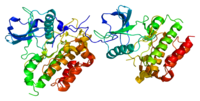
Loss of CXCR3 expression on memory B cells in individuals with long-standing type 1 diabetes
Sign Up to like & getrecommendations! Published in 2018 at "Diabetologia"
DOI: 10.1007/s00125-018-4651-x
Abstract: Aims/hypothesisIslet-specific autoantibodies can predict the development of type 1 diabetes. However, it remains unclear if B cells, per se, contribute to the causal pancreatic immunopathology. We aimed to identify phenotypic signatures of disease progression among… read more here.
Keywords: cxcr3; standing type; type diabetes; type ... See more keywords

CXCR3 contributes to neuropathic pain via ERK activation in the anterior cingulate cortex.
Sign Up to like & getrecommendations! Published in 2020 at "Biochemical and biophysical research communications"
DOI: 10.1016/j.bbrc.2020.07.104
Abstract: The anterior cingulate cortex (ACC) is activated by noxious stimuli and is involved in the affective component of pain processing; but its role in the sensory component of pain remains largely unknown. Studies have verified… read more here.
Keywords: cxcr3; cingulate cortex; neuropathic pain; anterior cingulate ... See more keywords

Inflammatory Activation of Astrocytes Facilitates Melanoma Brain Tropism via the CXCL10-CXCR3 Signaling Axis.
Sign Up to like & getrecommendations! Published in 2019 at "Cell reports"
DOI: 10.1016/j.celrep.2019.07.033
Abstract: Melanoma is the deadliest skin cancer due to its high rate of metastasis, frequently to the brain. Brain metastases are incurable; therefore, understanding melanoma brain metastasis is of great clinical importance. We used a mouse… read more here.
Keywords: melanoma; cxcr3; metastasis; cxcl10 ... See more keywords

The cardiac maladaptive ATF3-dependent cross-talk between cardiomyocytes and macrophages is mediated by the IFNγ-CXCL10-CXCR3 axis.
Sign Up to like & getrecommendations! Published in 2017 at "International journal of cardiology"
DOI: 10.1016/j.ijcard.2016.11.159
Abstract: RATIONAL Pressure overload induces adaptive and maladaptive cardiac remodeling processes in the heart. Part of the maladaptive process is the cross-talk between cardiomyocytes and macrophages which is dependent on the function of the Activating Transcription… read more here.
Keywords: cross talk; cxcr3; cardiomyocytes macrophages; cardiac remodeling ... See more keywords

Recruitment of CXCR3+ T cells into injured tissues in adult IgA vasculitis patients correlates with disease activity.
Sign Up to like & getrecommendations! Published in 2019 at "Journal of autoimmunity"
DOI: 10.1016/j.jaut.2019.01.012
Abstract: OBJECTIVES Adult immunoglobulin A vasculitis (IgAV) is an immune complex small vessel vasculitis. So far, the involvement of T cells in this pathology has been poorly studied. The aim of this study was to analyze… read more here.
Keywords: cxcr3; vasculitis; disease activity; cells injured ... See more keywords

CXCR3 expression in colorectal cancer cells enhanced invasion through preventing CXCR4 internalization
Sign Up to like & getrecommendations! Published in 2018 at "Experimental Cell Research"
DOI: 10.1016/j.yexcr.2018.08.006
Abstract: ABSTRACT One of the major causes of death in colorectal cancer (CRC) is invasion and metastasis. Better understanding of the molecular mechanism of CRC invasion and metastasis is essential in developing effective cancer therapies. Cooperative… read more here.
Keywords: cxcr3; invasion; expression; cell invasion ... See more keywords

IFNgamma-inducible CXCL10/CXCR3 axis alters the sensitivity of HEp-2 cells to ionizing radiation.
Sign Up to like & getrecommendations! Published in 2020 at "Experimental cell research"
DOI: 10.1016/j.yexcr.2020.112382
Abstract: Radiotherapy is a conventional approach for anti-cancer treatment, killing tumor cells through damaging cellular DNA. While increasing studies have demonstrated that tumors generated the tolerance to radiation and tumor immune system was found to be… read more here.
Keywords: cxcr3; hep cells; ifngamma; cxcl10 ... See more keywords

CXCR3 mediates ascites-directed tumor cell migration and predicts poor outcome in ovarian cancer patients
Sign Up to like & getrecommendations! Published in 2017 at "Oncogenesis"
DOI: 10.1038/oncsis.2017.29
Abstract: Intraabdominal tumor dissemination is a major hallmark of epithelial ovarian cancer (EOC), but the underlying mechanisms have not been fully elucidated. The CXCR3 chemokine receptor supports migration of tumor cells to metastatic sites, but its… read more here.
Keywords: cxcr3; tumor cell; ovarian cancer; cancer ... See more keywords

Upregulation of angiostatic chemokines IP-10/CXCL10 and I-TAC/CXCL11 in human obesity and their implication for adipose tissue angiogenesis
Sign Up to like & getrecommendations! Published in 2018 at "International Journal of Obesity"
DOI: 10.1038/s41366-018-0102-5
Abstract: Background/Aims:Impaired angiogenesis is linked to adipose tissue (AT) dysfunction, inflammation, and insulin resistance in human obesity. Chemokine (C-X-C motif) receptor. (CXCR3) ligands are important regulators of angiogenesis in different disease contexts such as cancer; however,… read more here.
Keywords: cxcr3; morbidly obese; cxcl11; angiogenesis ... See more keywords

TGFβ suppresses CD8+ T cell expression of CXCR3 and tumor trafficking
Sign Up to like & getrecommendations! Published in 2020 at "Nature Communications"
DOI: 10.1038/s41467-020-15404-8
Abstract: Transforming growth factor beta (TGFβ) is a multipotent immunosuppressive cytokine. TGFβ excludes immune cells from tumors, and TGFβ inhibition improves the efficacy of cytotoxic and immune therapies. Using preclinical colorectal cancer models in cell type-conditional… read more here.
Keywords: cxcr3; cd8; alk5; cd8 cells ... See more keywords

Histopathology and expression of the chemokines CXCL10, CXCL13, and CXCR3 and the endogenous TLR-4 ligand S100A8/A9 in lymph nodes of patients with adult-onset Still’s disease
Sign Up to like & getrecommendations! Published in 2019 at "Scientific Reports"
DOI: 10.1038/s41598-019-44032-6
Abstract: Adult-onset Still’s disease (AOSD) is a rare systemic inflammatory disease manifesting with a persistent high-spiking fever, a typical rash, and lymphadenopathy. Endogenous factors related to interleukin-1, such as S100A8/A9 and several chemokines including CXCL10, CXCR3,… read more here.
Keywords: onset still; cxcr3; adult onset; histopathology ... See more keywords